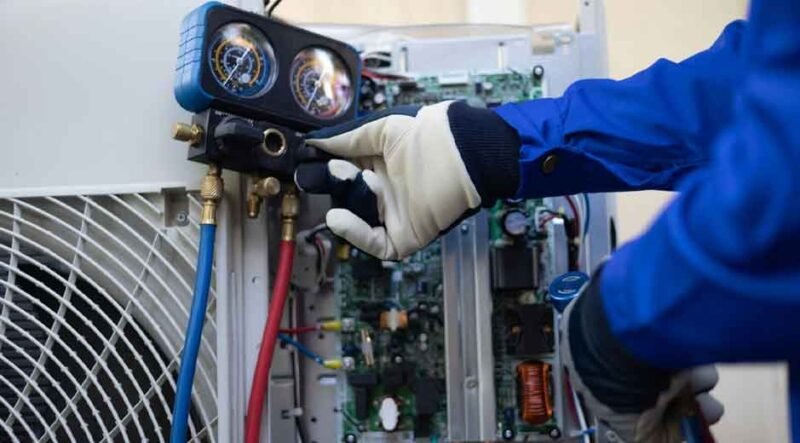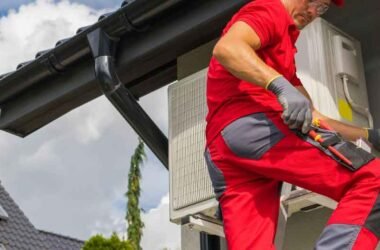Refrigerant leaks in air conditioning systems can significantly impact efficiency, performance, and overall comfort within homes and businesses. A system losing refrigerant often struggles to maintain the desired temperature, leading to higher energy bills and potential damage to the unit. Understanding the root causes and identifying solutions promptly is crucial for maintaining system longevity and ensuring consistent cooling. We will explore the various reasons behind refrigerant leaks and the strategies to address them, focusing on practical maintenance and repair approaches. Awareness of these factors helps homeowners and facility managers prevent small issues from escalating into costly repairs or replacements, maintaining both comfort and efficiency in HVAC systems.
Identifying Causes and Effective Solutions for Refrigerant Leaks
- Aging Equipment and Wear
Over time, air conditioning components naturally degrade due to continuous operation, vibration, and exposure to environmental factors. Pipes, fittings, and coils can develop small cracks or corrosion, allowing refrigerant to escape. Older systems are more susceptible to leaks because seals may harden or shrink, reducing their ability to contain the refrigerant effectively. Preventive maintenance, such as regular inspections and timely replacement of worn parts, can significantly reduce the risk of leaks. Routine checks enable technicians providing HVAC in Riverside services to identify early signs of deterioration, ensuring that minor issues are addressed before they compromise system efficiency or safety. Proactive maintenance extends the lifespan of the HVAC system and prevents sudden breakdowns during periods of peak usage.
- Poor Installation Practices
Improper installation of HVAC systems can be a significant source of refrigerant leaks. When connections between pipes and components are not properly tightened or brazed, refrigerant can seep out over time. Incorrect handling of refrigerant lines during installation can also damage the delicate tubing, creating micro leaks that are difficult to detect. Ensuring the system is installed according to manufacturer guidelines and industry standards is crucial to avoid such problems. Verification through pressure testing and vacuum checks after installation confirms that the system is sealed correctly, ensuring a leak-free operation that provides consistent cooling performance and energy efficiency from the outset.
- Physical Damage to System Components
External factors can cause physical damage to air conditioning systems, leading to refrigerant leaks. For instance, accidental impacts, debris, or corrosion from environmental conditions can puncture or weaken coils and lines. Even minor dents or scratches can compromise the integrity of the refrigerant containment system. Addressing these issues involves careful inspection and, if necessary, replacement of damaged components. Protective measures, such as installing shields or keeping equipment elevated and clear of obstructions, help prevent physical damage. Regular monitoring for signs of corrosion or wear can alert homeowners to potential vulnerabilities before a leak develops, maintaining both system performance and safety.
- Manufacturing Defects
Occasionally, refrigerant leaks occur due to inherent manufacturing defects in components, such as compressors, coils, or fittings. Faulty parts may fail prematurely, causing refrigerant to escape. While rare, these defects can impact system reliability and efficiency. Identifying and addressing manufacturing defects often involves thorough inspections and pressure tests to locate the source of the leak. Many manufacturers offer warranties on defective parts, allowing for replacement without incurring additional costs. Maintaining documentation of installation dates and service records can facilitate warranty claims, ensuring defective components are replaced promptly and preventing prolonged exposure to inefficient or compromised system performance.
- Inadequate Maintenance and Neglect
Lack of regular maintenance is one of the most common contributors to refrigerant leaks. Over time, dust, dirt, and debris can accumulate on coils and connections, causing corrosion and weakening the integrity of refrigerant lines. Filters that are not replaced or cleaned can restrict airflow, leading to pressure imbalances that stress the system and increase the likelihood of leaks. Implementing a consistent maintenance schedule, including coil cleaning, filter replacement, and system checks, reduces the risk of leaks. Technicians can also use leak detection tools, such as electronic detectors or dye testing, during routine visits to identify and address emerging issues before they escalate into larger problems.
- Environmental and Operating Conditions
Extreme temperatures, humidity, and exposure to harsh elements can exacerbate wear on HVAC systems, increasing the probability of refrigerant leaks. Systems operating in coastal areas may face additional challenges due to salt exposure, which accelerates corrosion. High-pressure cycles or frequent cycling of the unit can also stress components, leading to micro leaks over time. Proper system design and placement can mitigate these environmental impacts. For example, installing the unit in a shaded or sheltered location and ensuring adequate ventilation can reduce stress on critical components. Understanding the environmental risks specific to the installation site enables the implementation of preventive strategies that maintain refrigerant integrity and system performance.
- Prompt Detection and Repair Solutions
Early detection is key to minimizing the impact of refrigerant leaks. Visual inspections, listening for unusual noises, and monitoring system performance can provide initial indicators of a leak. Professional technicians utilize specialized tools to accurately locate and repair leaks. Solutions may include tightening connections, replacing faulty components, or sealing small cracks in coils. In some cases, recharging the system with refrigerant is necessary, but this should only occur after leaks have been fixed to prevent repeated loss. Combining detection with corrective measures ensures the system operates efficiently, conserves energy, and avoids potential damage to compressors or other critical components.
Refrigerant leaks pose a serious challenge to maintaining efficient and reliable air conditioning systems. They can stem from aging equipment, installation errors, physical damage, manufacturing defects, inadequate maintenance, and environmental factors. Prompt detection, thorough inspections, and timely repairs are essential to mitigate these issues and preserve system performance. Preventive maintenance, careful handling, and awareness of operational conditions significantly reduce the likelihood of leaks, ensuring long-term reliability and comfort. Understanding the causes and solutions for refrigerant leaks empowers homeowners and facility managers to maintain efficient, cost-effective HVAC systems, ultimately protecting both their investment and the environment in which they live.









